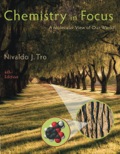
Interpretation:
The energy produced (in kilocalories) in 1 second and the consumption of coal and natural gas (in kilogram) are to be calculated.
Concept introduction:
The power derived from the utilization of chemical or physical resources to provide heat and light or to carry out various processes is known as energy. The SI unit of energy is joule.
Unit conversion is a multiple-step process that is used to convert the unit of measurement of a given quantity. It is determined by multiplicaiton with a conversion factor.
The useful energy derived can be calculated by using the equation:
Conversion factor megajoules to joule is
Conversion factor calorie to kilocalorie is
Answer to Problem 44E
Solution:
Explanation of Solution
a) The number of kilocalories produce in 1 s.
The energy produced in one second by the power plant is given as:
The kilocalorie produced in one second is calculated as follows:
First, convert megajoule into joule, then joule into calorie, and then calorie into kilocalorie.
Conversion of megajoule into kilocalorie is as follows:
Therefore, the kilocalorie produced in one second is
b) The amount of energy it consumes in 1 s if its efficiency is 34%.
The total energy consumed in one second is calculated as follows:
The equation used to calculate the total energy consumed is represented as follows:
The total energy produced in one second is
The efficiency of a person is
Conversion of percentage into decimal:
Substitute the values in the given equation:
Or
The energy consumed in MJ is calculated as follows:
Therefore, the energy consumed (in MJ) is
c) The consumption of coal in 1 s if the power plant were coal fired.
The consumption of coal (in kilogram) is calculated as follows:
First, the energy consumed is divided by the heat of combustion of coal. Then, it is converted into kilograms.
Conversion of kilocalorie into kilogram is as follows:
The energy consumed is
The heat of combustion of coal is
Therefore,
Therefore, the consumption of coal (in kilogram) is
d) The consumption of natural gas in 1 s if the power plant were natural gas fired.
The consumption of natural gas (in kilogram) is calculated as follows:
First, the energy consumed is divided by the heat of combustion of natural gas. Then, it is converted into kilograms.
Conversion of kilocalorie into kilogram is as follows:
The energy consumed is
The heat of combustion of natural gas is
Therefore,
Therefore, the consumption of natural gas (in kilogram) is
Want to see more full solutions like this?
Chapter 9 Solutions
Chemistry In Focus
- ← Problem 14 of 31 Submit Draw the major product for this reaction. Ignore inorganic byproducts. 1. BH3-THF 2. H2O2, NaOHarrow_forwardClassify each amino acid below as nonpolar, polar neutral, polar acidic, or polar basic.arrow_forwarddraw skeletal structures for the minor products of the reaction.arrow_forward
- 1. Provide missing starting materials, reagents, products. If a product cannot be made, write NP (not possible) in the starting material box. C7H12O Ph HO H 1) 03-78 C 2) Me₂S + Ph .H OH + 2nd stereoisomer OH Ph D + enantiomer cat OsO 4 NMO H2O acetonearrow_forwardPlease note that it is correct and explains it rightly:Indicate the correct option. The proportion of O, C and H in the graphite oxide is:a) Constant, for the quantities of functional groups of acids, phenols, epoxy, etc. its constants.b) Depending on the preparation method, as much oxidant as the graphite is destroyed and it has less oxygen.c) Depends on the structure of the graphic being processed, whether it can be more tridimensional or with larger crystals, or with smaller crystals and with more edges.arrow_forwardCheck the box under each a amino acid. If there are no a amino acids at all, check the "none of them" box under the table. Note for advanced students: don't assume every amino acid shown must be found in nature. ནང་་་ OH HO HO NH2 + NH3 O OIL H-C-CO CH3-CH O C=O COOH COOH + H2N C-H O H2N C H CH3-CH CH2 HO H3N O none of them 口 CH3 CH2 OH Хarrow_forward
- What is the systematic name of the product P of this chemical reaction? 010 HO-CH2-CH2-C-OH ☐ + NaOH P+ H2Oarrow_forward1. Provide missing starting materials, reagents, products. If a product cannot be made, write NP (not possible) in the starting material box. a) C10H12 Ph OMe AcOHg+ + enantiomer Br C6H10O2 + enantiomerarrow_forwardDraw the Fischer projection of the most common naturally-occurring form of cysteine, with the acid group at the top and the side chain at the bottom. Important: be sure your structure shows the molecule as it would exist at physiological pH. Click and drag to start drawing a structure. :☐ ©arrow_forward
- Draw an a amino acid with an ethyl (-CH2-CH3) side chain. Draw the molecule as it would appear at physiological pH. Click and drag to start drawing a structure. :□ S टेarrow_forwardWrite the systematic name of each organic molecule: HO Cl structure O OH O HO OH name ☐ OH OH ☐ OH ☐arrow_forwardWrite the name of a naturally-occuring hydrophillic amino acid. (You will find the structures of the naturally-occuring amino acids in the ALEKS Data resource.) × $arrow_forward

 Living By Chemistry: First Edition TextbookChemistryISBN:9781559539418Author:Angelica StacyPublisher:MAC HIGHER
Living By Chemistry: First Edition TextbookChemistryISBN:9781559539418Author:Angelica StacyPublisher:MAC HIGHER Chemistry by OpenStax (2015-05-04)ChemistryISBN:9781938168390Author:Klaus Theopold, Richard H Langley, Paul Flowers, William R. Robinson, Mark BlaserPublisher:OpenStax
Chemistry by OpenStax (2015-05-04)ChemistryISBN:9781938168390Author:Klaus Theopold, Richard H Langley, Paul Flowers, William R. Robinson, Mark BlaserPublisher:OpenStax Chemistry & Chemical ReactivityChemistryISBN:9781133949640Author:John C. Kotz, Paul M. Treichel, John Townsend, David TreichelPublisher:Cengage Learning
Chemistry & Chemical ReactivityChemistryISBN:9781133949640Author:John C. Kotz, Paul M. Treichel, John Townsend, David TreichelPublisher:Cengage Learning Chemistry & Chemical ReactivityChemistryISBN:9781337399074Author:John C. Kotz, Paul M. Treichel, John Townsend, David TreichelPublisher:Cengage Learning
Chemistry & Chemical ReactivityChemistryISBN:9781337399074Author:John C. Kotz, Paul M. Treichel, John Townsend, David TreichelPublisher:Cengage Learning ChemistryChemistryISBN:9781305957404Author:Steven S. Zumdahl, Susan A. Zumdahl, Donald J. DeCostePublisher:Cengage Learning
ChemistryChemistryISBN:9781305957404Author:Steven S. Zumdahl, Susan A. Zumdahl, Donald J. DeCostePublisher:Cengage Learning





